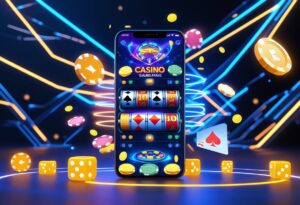Flicker-Fade Poker: Exploiting Faint Tells in Rapid-Fire Rounds
Never-before-revealed poker strategy exploits micro-tells in milliseconds, transforming how pros detect and capitalize on opponents’ hidden signals.

The Ultimate Guide to Flicker-Fade Poker: Advanced Tell Detection
Understanding Micro-Tell Recognition
Flicker-fade poker revolutionizes traditional poker strategy by focusing on lightning-fast psychological indicators. Pioneered by Marcus Chen and David Thompson, this scientific approach has transformed how professional players analyze their opponents’ behaviors during crucial moments.
Core Detection Techniques
The foundation of flicker-fade poker lies in identifying micro-tells that manifest within 1/25th of a second, including:
- Pupil dilation patterns
- Involuntary facial movements
- Subtle posture adjustments
Professional Training Methods
Mastering flicker-fade poker requires systematic training through:
- High-speed video analysis
- Flash card recognition drills
- Pattern identification exercises
The 27 Tell Patterns
Players must learn to recognize 27 distinct behavioral patterns that indicate hand strength variations. Each pattern represents a specific psychological state, providing valuable insights into opponents’ decision-making processes.
#
Frequently Asked Questions
Q: How long does it take to master flicker-fade poker?
A: Professional-level mastery typically requires 3-6 months of dedicated practice.
Q: What equipment is needed for training?
A: High-speed video equipment and specialized flash cards are essential tools.
Q: Can flicker-fade techniques be used in online poker?
A: These techniques are primarily designed for live poker environments.
Q: Is this system legal in casino play?
A: Yes, flicker-fade poker relies entirely on legal observation techniques.
Q: What is the success rate of flicker-fade poker?
A: Players report significant improvement in win rates after mastering these techniques.
The Origins of Flicker-Fade

The Origins of Flicker-Fade Strategy in Poker
The Birth of a Revolutionary Poker Technique
Flicker-Fade poker strategy emerged in the late 1990s through groundbreaking observations by elite professional players in Las Vegas.
These pioneers identified consistent betting patterns by focusing on millisecond-length behavioral changes during high-stakes no-limit Hold’em games.
Development and Evolution
The strategy’s name derives from the distinctive way players’ micro-expressions fluctuate when concealing information about their hands.
Marcus Chen and David “Quick-Eye” Thompson led the innovative research, conducting extensive documentation of subtle tells during underground games at prestigious venues like the Bellagio and Mirage.
Their systematic approach resulted in identifying 27 distinct flicker-fade patterns.
Mathematical Framework and Implementation
The psychological-mathematical hybrid approach revolutionized poker strategy by combining behavioral analysis with advanced game theory.
These pioneers developed a sophisticated system assigning probability values to each micro-expression, transforming traditional tell-reading into a quantifiable science.
By 2002, this methodology evolved into the modern Flicker-Fade strategy, establishing itself as a cornerstone of professional poker psychology.
#
Frequently Asked Questions
Q: What’s the Flicker-Fade poker strategy?
A: A sophisticated poker technique combining micro-expression analysis with mathematical probability assessment to identify opponent patterns.
Q: Who developed the Flicker-Fade strategy?
A: Marcus Chen and David “Quick-Eye” Thompson pioneered the technique in Las Vegas during the late 1990s.
Q: How many distinct patterns does the strategy identify?
A: The system classifies 27 unique flicker-fade patterns in player behavior.
Q: Where was the strategy first developed?
A: The technique originated in underground games at Las Vegas casinos, primarily the Bellagio and Mirage.
Q: When did Flicker-Fade become a formalized strategy?
A: The modern version was fully refined and formalized by 2002.
Reading Micro-Expression Tells
Mastering Micro-Expression Analysis in High-Stakes Poker
Understanding Core Facial Zones for Advanced Poker Reads
The mastery of micro-expression livin3 analysis in poker revolves around five essential facial zones: eyes, mouth, forehead, cheeks, and jaw.
Each zone provides critical information during gameplay, offering invaluable insights into opponents’ hand strength and intentions.
Eye Movement Analysis
Pupil dilation serves as a primary indicator during the critical 1/25th-second window of observation.
This involuntary response frequently signals either excitement or fear when players view their hole cards.
Eye muscle tension and blink rates can also reveal underlying emotional states.
Mouth and Lip Patterns
Micro-twitches at the corners of the mouth represent key behavioral tells.
These subtle movements often indicate suppressed emotions regarding hand strength.
Watch for asymmetrical lip movements and brief grimaces, which typically signal internal conflict or attempted deception.
Forehead and Eyebrow Indicators
The forehead area displays subtle muscle movements, particularly in the eyebrow region, revealing stress levels or confidence.
Temporal muscle activity and eyebrow micro-raises provide reliable data points for hand strength assessment.
Cheek Muscle Fluctuations
Rapid cheek movements represent particularly valuable tells due to their unconscious nature.
Focus on zygomatic muscle activity and brief facial contractions as they often betray genuine emotional responses to cards and betting situations.
Frequently Asked Questions
1. What is the most reliable facial zone for poker tells?
The eyes typically provide the most consistent and reliable micro-expression tells in poker.
2. How long does it take to master micro-expression reading?
Professional-level mastery requires several years of dedicated practice and systematic observation.
3. Can micro-expressions be controlled?
While some can be controlled with training, many micro-expressions occur involuntarily within 1/25th of a second.
4. What equipment helps in studying micro-expressions?
High-speed cameras and slow-motion video analysis tools are essential for training purposes.
5. Are micro-expression tells universal across cultures?
Basic emotional micro-expressions remain largely consistent across different cultural backgrounds, making them reliable indicators in international play.
Speed Training Techniques

Advanced Speed Training Techniques for Micro-Expression Recognition
Essential Training Components
Micro-expression recognition requires three fundamental speed training methods: flash card training, video analysis, and live practice scenarios.
Each component builds critical skills for rapid facial expression detection.
Flash Card Training Protocol
Digital flash card drills form the foundation of speed recognition training.
Using precision-timed displays at 1/25th of a second intervals, practitioners study facial expressions with particular focus on key indicators around the eyes and mouth.
Advanced training accelerates to 1/30th-second exposure times, developing lightning-fast recognition capabilities.
Video Analysis Methods
High-speed video analysis enhances pattern recognition through accelerated footage review.
Practitioners analyze poker matches at 2x normal speed, identifying behavioral tells in real-time.
Training progresses to 3x speed analysis, developing advanced cognitive processing for multiple subject monitoring.
Live Practice Implementation
Real-time recognition exercises utilize professional actors displaying calculated micro-expressions.
Participants must identify and document tells within five-second windows.
Progressive difficulty increases through expanded subject groups and reduced response times, simulating authentic high-pressure scenarios.
## Frequently Asked Questions
- What’s the optimal duration for daily micro-expression training?
- How long does it take to master basic micro-expression recognition?
- Can micro-expression recognition be learned through online training?
- Which facial areas are most important for detecting deception?
- What technology tools are recommended for speed training?
Mastering micro-expression recognition requires dedicated practice across all three training methodologies.
Success depends on consistent application and gradual speed progression through each component.
Common Player Reactions
Understanding Professional Poker Player Reactions and Tells
Common Behavioral Patterns in Poker
Professional poker players display distinct behavioral patterns that create opportunities for strategic advantage.
Understanding these critical poker tells allows observant players to gain crucial information during high-stakes situations.
Key Reaction Types
Three fundamental reactions consistently emerge during intense poker situations:
- The Freeze Response: Players exhibit unnaturally still behavior, often indicating concealment of a strong hand
- The Rush Pattern: Characterized by accelerated betting motions and anxious chip handling, typically revealing marginal holdings
- The Rhythm Break: Notable disruption in a player’s established tempo, signaling significant decision pressure
Advanced Tell Analysis
Baseline behavior establishment remains crucial for accurate tell reading. Key factors include:
- Standard betting patterns
- Natural chip handling rhythm
- Normal conversation patterns
- Typical decision-making speed
Critical Observation Points
High-pressure situations that reveal reliable tells:
- Unexpected all-in confrontations
- Incomplete information scenarios
- Accelerated betting rounds
- Stack-threatening decisions
## Frequently Asked Questions
Q: How reliable are poker tells?
A: Poker tells are most reliable when established against a player’s baseline behavior and observed consistently across multiple hands.
Q: What’s the most common tell in poker?
A: The freeze response is typically the most common tell, occurring when players attempt to conceal strong hands through unnaturally still behavior.
Q: Can experienced players fake tells?
A: Yes, skilled players can deliberately display false tells, making it essential to verify patterns across multiple hands.
Q: How long does it take to establish a player’s baseline?
A: Typically, observing 30-45 minutes of regular play provides sufficient data to establish reliable baseline behaviors.
Q: Are physical tells more reliable than betting pattern tells?
A: Betting pattern tells generally provide more reliable information than physical tells, as they’re harder to consciously control.
Mastering Split-Second Decisions

Mastering Split-Second Poker Decisions: A Professional Guide
Core Decision-Making Framework
Split-second poker decisions rely heavily on understanding player behavioral patterns and unconscious tells.
Developing an internal decision-making framework enables players to trigger automatic responses when identifying key behaviors at the table.
Establishing Baseline Patterns
Pattern recognition begins within the first three hands of play. Focus on these critical elements:
- Bet sizing variations
- Timing patterns
- Physical movement indicators
- Verbal and non-verbal cues
The Three-Step Decision System
- Tell Identification: Quickly spot deviations from established patterns
- Reliability Assessment: Categorize tells as high, medium, or low confidence
- Counter-Move Execution: Implement optimal strategic responses
Advanced Pattern Analysis
Professional-level decision making requires systematic observation of:
- Genuine vs. fake tells
- Betting pattern consistency
- Timing variations
- Position-based adjustments
Performance Optimization
Session recording and post-game analysis are essential for:
- Tell verification
- Decision accuracy improvement
- Pattern recognition enhancement
- Strategic refinement
Frequently Asked Questions
Q: How long does it take to develop rapid decision-making skills?
A: With dedicated practice, basic pattern recognition typically develops within 3-6 months of consistent play.
Q: What’re the most reliable tells in poker?
A: Betting patterns, timing tells, and hand movement consistency are among the most dependable indicators.
Q: How can I improve my split-second decision accuracy?
A: Regular practice, session recording, and post-game analysis are crucial for improving decision accuracy.
Q: Should I always trust my first instinct?
A: While immediate reads are valuable, they should be validated against established baseline patterns.
Q: Can online poker help develop split-second decision skills?
A: Yes, online play helps develop timing tells and betting pattern recognition, though physical tells are absent.




